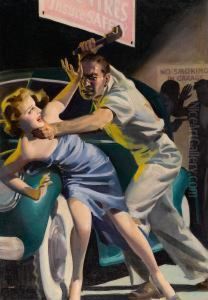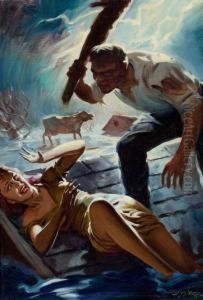Hugh Joseph Ward Paintings
Hugh Joseph Ward, born in 1909 in Philadelphia, Pennsylvania, was an American artist renowned for his significant contributions to the world of pulp magazine cover art during the 1930s and 1940s. Ward's career, though brief due to his untimely death in 1945 at the age of 36, left an indelible mark on the pulp art genre with his distinctive style and vivid imagery. His work primarily adorned the covers of pulp fiction magazines, a popular form of entertainment during the early 20th century, known for their sensational stories of adventure, crime, and romance.
Ward received his formal education in art at the Pennsylvania Academy of the Fine Arts, one of the country's leading art schools. His talent and dedication to his craft were evident from his early years, and upon completing his studies, he quickly made a name for himself in the commercial art world. Ward's transition into the realm of pulp magazine covers was marked by his collaboration with the publisher Culture Publications, where he became the primary cover artist for the magazine 'Spicy Detective Stories.' His covers for 'Spicy Detective' and other magazines like 'Spicy Mystery Stories' and 'Spicy Adventure Stories' are particularly remembered for their dramatic and often provocative portrayals of danger, seduction, and intrigue.
Ward's artistic style was characterized by his masterful use of color, composition, and lighting, which brought his subjects to life with a dynamic sense of movement and emotion. His paintings often featured daring heroines and nefarious villains in scenarios that captivated the imagination of the magazine's readership. Despite the formulaic nature of many pulp magazine stories, Ward's covers elevated the material, contributing to the magazines' allure and commercial success.
Tragically, Hugh Joseph Ward's career was cut short when he passed away from leukemia in 1945. Despite his relatively short life and career, Ward's influence on the field of illustration and pulp art remains significant. His work continues to be celebrated for its artistic merit and its role in defining the visual aesthetic of pulp fiction in the early 20th century. Today, original Hugh J. Ward magazine covers are highly prized by collectors and serve as a testament to his skill as an illustrator and his contribution to American popular culture.

